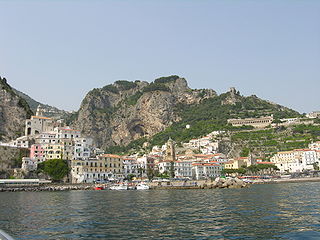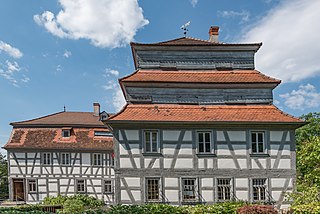Related Research Articles

Amalfi is a town and comune in the province of Salerno, in the region of Campania, Italy, on the Gulf of Salerno. It lies at the mouth of a deep ravine, at the foot of Monte Cerreto, surrounded by dramatic cliffs and coastal scenery. The town of Amalfi was the capital of the maritime republic known as the Duchy of Amalfi, an important trading power in the Mediterranean between 839 and around 1200.

Papermaking is the manufacture of paper and cardboard, which are used widely for printing, writing, and packaging, among many other purposes. Today almost all paper is made using industrial machinery, while handmade paper survives as a specialized craft and a medium for artistic expression.

Pulp is a fibrous lignocellulosic material prepared by chemically, semi-chemically or mechanically producing cellulosic fibers from wood, fiber crops, waste paper, or rags. Mixed with water and other chemicals or plant-based additives, pulp is the major raw material used in papermaking and the industrial production of other paper products.

The pulp and paper industry comprises companies that use wood, specifically pulpwood, as raw material and produce pulp, paper, paperboard, and other cellulose-based products.

A paper mill is a factory devoted to making paper from vegetable fibres such as wood pulp, old rags, and other ingredients. Prior to the invention and adoption of the Fourdrinier machine and other types of paper machine that use an endless belt, all paper in a paper mill was made by hand, one sheet at a time, by specialized laborers.

A paper machine is an industrial machine which is used in the pulp and paper industry to create paper in large quantities at high speed. Modern paper-making machines are based on the principles of the Fourdrinier Machine, which uses a moving woven mesh to create a continuous paper web by filtering out the fibres held in a paper stock and producing a continuously moving wet mat of fibre. This is dried in the machine to produce a strong paper web.
Sizing or size is a substance that is applied to, or incorporated into, other materials—especially papers and textiles—to act as a protective filler or glaze. Sizing is used in papermaking and textile manufacturing to change the absorption and wear characteristics of those materials.

The recycling of paper is the process by which waste paper is turned into new paper products. It has a number of important benefits: It saves waste paper from occupying homes of people and producing methane as it breaks down. Because paper fibre contains carbon, recycling keeps the carbon locked up for longer and out of the atmosphere. Around two-thirds of all paper products in the US are now recovered and recycled, although it does not all become new paper. After repeated processing the fibres become too short for the production of new paper, which is why virgin fibre is frequently added to the pulp recipe.

Wove paper is a type of paper first created centuries ago in the Orient, and subsequently introduced to England, Europe and the American colonies in the mid-eighteenth century. Hand-made wove paper was first produced by using a wooden mould that contained a finely-woven brass vellum, upon which the paper pulp was applied and dried, creating a smooth, uniform surface.
Cotton paper, also known as rag paper or rag stock paper, is made using cotton linters or cotton from used cloth (rags) as the primary material. Prior to the mid-19th century, cotton paper was the main form of paper produced, with pulp paper replacing cotton paper as the main paper material during the 19th century. Although pulp paper was cheaper to produce, its quality and durability is significantly lower. Although pulp-paper quality improved significantly over the 20th century, cotton paper continues to be more durable, and consequently important documents are often printed on cotton paper. Different grades of cotton paper can be produced.
Printing and writing papers are paper grades used for newspapers, magazines, catalogs, books, notebooks, commercial printing, business forms, stationeries, copying and digital printing. About 1/3 of the total pulp and paper marked is printing and writing papers. The pulp or fibers used in printing and writing papers are extracted from wood using a chemical or mechanical process.

A writing material is a surface that can be written on with suitable instruments, or used for symbolic or representational drawings. Building materials on which writings or drawings are produced are not included. The gross characterization of writing materials is by the material constituting the writing surface and the number, size, usage, and storage configuration of multiple surfaces into a single object. Writing materials are often paired with specific types of writing instruments. Other important attributes of writing material are its reusability, permanence, and resistance to fraudulent misuse.
The sulfite process produces wood pulp that is almost pure cellulose fibers by treating wood chips with solutions of sulfite and bisulfite ions. These chemicals cleave the bonds between the cellulose and lignin components of the lignocellulose. A variety of sulfite/bisulfite salts are used, including sodium (Na+), calcium (Ca2+), potassium (K+), magnesium (Mg2+), and ammonium (NH4+). The lignin is converted to lignosulfonates, which are soluble and can be separated from the cellulose fibers. For the production of cellulose, the sulfite process competes with the Kraft process which produces stronger fibers and is less environmentally costly.

Paper is a thin sheet material produced by mechanically or chemically processing cellulose fibres derived from wood, rags, grasses, or other vegetable sources in water, draining the water through a fine mesh leaving the fibre evenly distributed on the surface, followed by pressing and drying. Although paper was originally made in single sheets by hand, almost all is now made on large machines—some making reels 10 metres wide, running at 2,000 metres per minute and up to 600,000 tonnes a year. It is a versatile material with many uses, including printing, painting, graphics, signage, design, packaging, decorating, writing, and cleaning. It may also be used as filter paper, wallpaper, book endpaper, conservation paper, laminated worktops, toilet tissue, currency, and security paper, or in a number of industrial and construction processes.
Mummy paper is paper that is claimed to be made from the linen wrappings and other fibers from Egyptian mummies imported to America circa 1855. The existence of this paper has not been conclusively confirmed, but it has been widely discussed.
Deinking is the industrial process of removing printing ink from paperfibers of recycled paper to make deinked pulp.

Paper is a thin nonwoven material traditionally made from a combination of milled plant and textile fibres. The first paper-like plant-based writing sheet was papyrus in Egypt, but the first true papermaking process was documented in China during the Eastern Han period, traditionally attributed to the court official Cai Lun. This plant-puree conglomerate produced by pulp mills and paper mills was used for writing, drawing, and money. During the 8th century, Chinese paper making spread to the Islamic world, replacing papyrus. By the 11th century, papermaking was brought to Europe, where it replaced animal-skin-based parchment and wood panels. By the 13th century, papermaking was refined with paper mills using waterwheels in Spain. Later improvements to the papermaking process came in 19th century Europe with the invention of wood-based papers.

The Paper and Watermark Museum is a museum of Fabriano, Italy. Based on the paper-making tradition of Fabriano, which is documented since the 12th Century, the museum focusses on handmade paper and watermark techniques in Medieval Italy.

The Paper Mill Homburg, built in 1807, is located in Triefenstein-Homburg am Main. It was used until 1975 for the commercial production of paper and cardboard and was renovated 1994 to 1997 as a paper mill museum. The production facilities with original machines and equipment are preserved.

The Paper Museum in Pescia is the only museum in Tuscany that records, documents, protects, and passes down to the public the art of handmade paper. Its purpose is to preserve the ancient art of processing and manufacturing handmade paper and to raise awareness of the importance and evolution of paper production.
References
- ↑ Fuga, Antonella (2006). Artists' techniques and materials. J. Paul Getty Museum. p. 56. ISBN 978-0-89236-860-0.
- ↑ Reynolds, Paula (2023-03-21). "From rags to riches: Amalfi's ancient paper-making practice lives on". L'Italo-Americano. Retrieved 2024-04-01.
- ↑ Castagnari, Giancarlo (2007). L'impiego delle tecniche e dell'opera dei cartai fabrianesi in Italia e in Europa: atti delle giornate europee di studio : Fabriano 16-17 giugno 2006 (in Italian). Cartiere Miliani. p. 346.